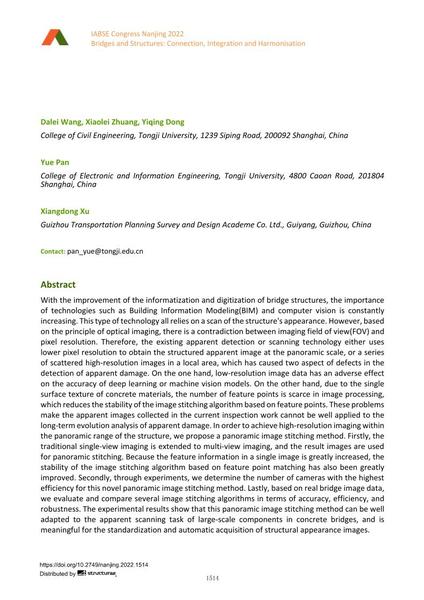A Novel Method for Generating Apparent Panoramic Image of Real Texture of Concrete Bridge Based on Multi-View Registration

|
|
|||||||||||
Bibliografische Angaben
| Autor(en): |
Dalei Wang
(College of Civil Engineering, Tongji University, 1239 Siping Road, 200092 Shanghai, China)
Xiaolei Zhuang (College of Civil Engineering, Tongji University, 1239 Siping Road, 200092 Shanghai, China) Yiqing Dong (College of Civil Engineering, Tongji University, 1239 Siping Road, 200092 Shanghai, China) Yue Pan (College of Electronic and Information Engineering, Tongji University, 4800 Caoan Road, 201804 Shanghai, China) Xiangdong Xu (Guizhou Transportation Planning Survey and Design Academe Co. Ltd., Guiyang, Guizhou, China) |
||||
|---|---|---|---|---|---|
| Medium: | Tagungsbeitrag | ||||
| Sprache(n): | Englisch | ||||
| Tagung: | IABSE Congress: Bridges and Structures: Connection, Integration and Harmonisation, Nanjing, People's Republic of China, 21-23 September 2022 | ||||
| Veröffentlicht in: | IABSE Congress Nanjing 2022 | ||||
|
|||||
| Seite(n): | 1514-1520 | ||||
| Anzahl der Seiten (im PDF): | 7 | ||||
| DOI: | 10.2749/nanjing.2022.1514 | ||||
| Abstrakt: |
With the improvement of the informatization and digitization of bridge structures, the importance of technologies such as Building Information Modeling(BIM) and computer vision is constantly increasing. This type of technology all relies on a scan of the structure's appearance. However, based on the principle of optical imaging, there is a contradiction between imaging field of view(FOV) and pixel resolution. Therefore, the existing apparent detection or scanning technology either uses lower pixel resolution to obtain the structured apparent image at the panoramic scale, or a series of scattered high-resolution images in a local area, which has caused two aspect of defects in the detection of apparent damage. On the one hand, low-resolution image data has an adverse effect on the accuracy of deep learning or machine vision models. On the other hand, due to the single surface texture of concrete materials, the number of feature points is scarce in image processing, which reduces the stability of the image stitching algorithm based on feature points. These problems make the apparent images collected in the current inspection work cannot be well applied to the long-term evolution analysis of apparent damage. In order to achieve high-resolution imaging within the panoramic range of the structure, we propose a panoramic image stitching method. Firstly, the traditional single-view imaging is extended to multi-view imaging, and the result images are used for panoramic stitching. Because the feature information in a single image is greatly increased, the stability of the image stitching algorithm based on feature point matching has also been greatly improved. Secondly, through experiments, we determine the number of cameras with the highest efficiency for this novel panoramic image stitching method. Lastly, based on real bridge image data, we evaluate and compare several image stitching algorithms in terms of accuracy, efficiency, and robustness. The experimental results show that this panoramic image stitching method can be well adapted to the apparent scanning task of large-scale components in concrete bridges, and is meaningful for the standardization and automatic acquisition of structural appearance images. |
||||
| Stichwörter: |
Brückeninspektion
|
||||
| Copyright: | © 2022 International Association for Bridge and Structural Engineering (IABSE) | ||||
| Lizenz: | Die Urheberrechte (Copyright) für dieses Werk sind rechtlich geschützt. Es darf nicht ohne die Zustimmung des Autors/der Autorin oder Rechteinhabers/-in weiter benutzt werden. |
||||
